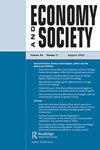标准之城:伦敦和LIBOR在全球金融中的崛起
IF 4.3
2区 社会学
Q1 ECONOMICS
引用次数: 0
摘要
20世纪后期全球金融的兴起是资本主义历史上的一个划时代的转变,新的社会技术设备出现了,以重视这些创新,其中最重要的是伦敦银行同业拆借利率(LIBOR)。如今,伦敦银行同业拆借利率在全球金融市场的价值超过200万亿美元,尽管自2012年臭名昭著的丑闻以来,国际监管机构一再试图废除这一基准。伦敦银行间拆放款利率(LIBOR)是如何在全球金融中崛起的?在本文中,我对LIBOR在全球金融中的崛起进行了历史分析,追溯其在20世纪60年代作为欧洲美元银团贷款的非标准化利率的出现,到20世纪80年代作为伦敦不断增长的衍生品市场的标准化基准的演变。在追溯LIBOR的上升过程中,我认为全球金融市场是由伦敦金融中心特有的实践和规范塑造的。最后,我提出了“位置性”的概念,以帮助将全球金融的建构理论化。本文章由计算机程序翻译,如有差异,请以英文原文为准。
City of standards: London and the rise of LIBOR in global finance
Abstract The rise of global finance in the latter twentieth century was an epochal transformation in the history of capitalism and new socio-technical devices emerged to value these innovations, among the most significant being the London Interbank Offered Rate (LIBOR). Today, LIBOR values over $200 trillion in global financial markets despite the repeated attempts by international regulators to repeal the benchmark since its infamous scandal in 2012. How did LIBOR ever rise to its apotheosis in global finance? In this paper, I provide a historical analysis of the rise of LIBOR in global finance, tracing its emergence as an unstandardized rate for eurodollar syndicated loans in the 1960s to its evolution as a standardized benchmark for the growing derivative market in London by the 1980s. In tracing the rise of LIBOR, I argue that global financial markets were shaped by practices and norms particular to the financial centre of London. I conclude by offering the concept of ‘positionality’ to help theorize the construction of global finance.
求助全文
通过发布文献求助,成功后即可免费获取论文全文。
去求助
来源期刊

Economy and Society
Multiple-
CiteScore
6.30
自引率
5.90%
发文量
23
期刊介绍:
This radical interdisciplinary journal of theory and politics continues to be one of the most exciting and influential resources for scholars in the social sciences worldwide. As one of the field"s leading scholarly refereed journals, Economy and Society plays a key role in promoting new debates and currents of social thought. For 37 years, the journal has explored the social sciences in the broadest interdisciplinary sense, in innovative articles from some of the world"s leading sociologists and anthropologists, political scientists, legal theorists, philosophers, economists and other renowned scholars.
 求助内容:
求助内容: 应助结果提醒方式:
应助结果提醒方式:


